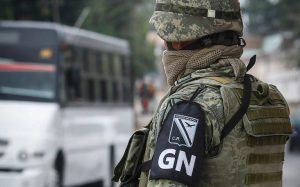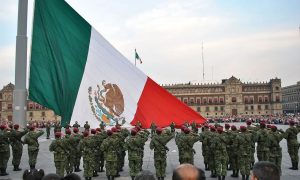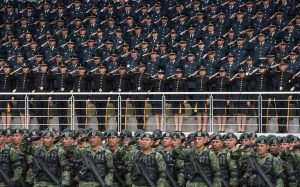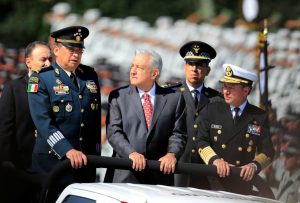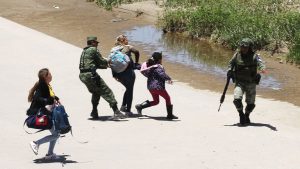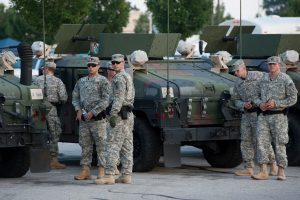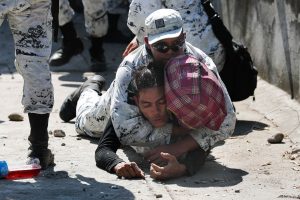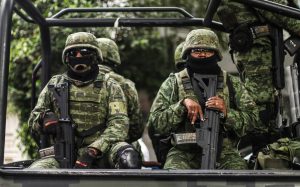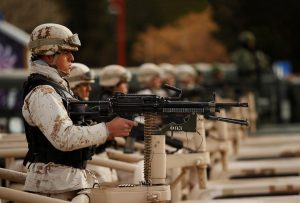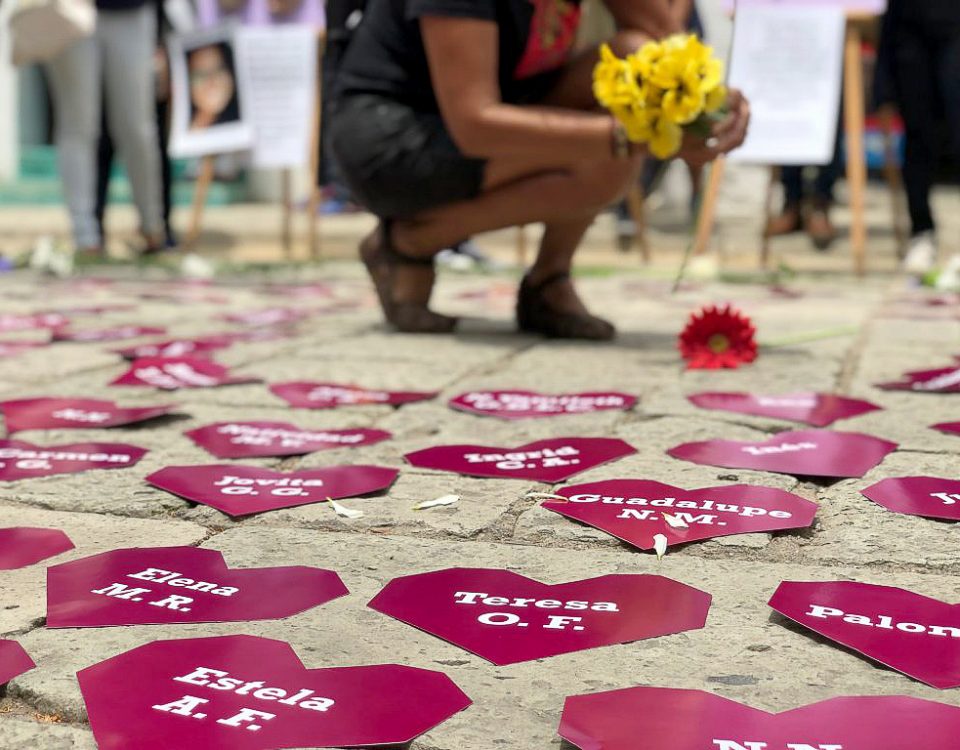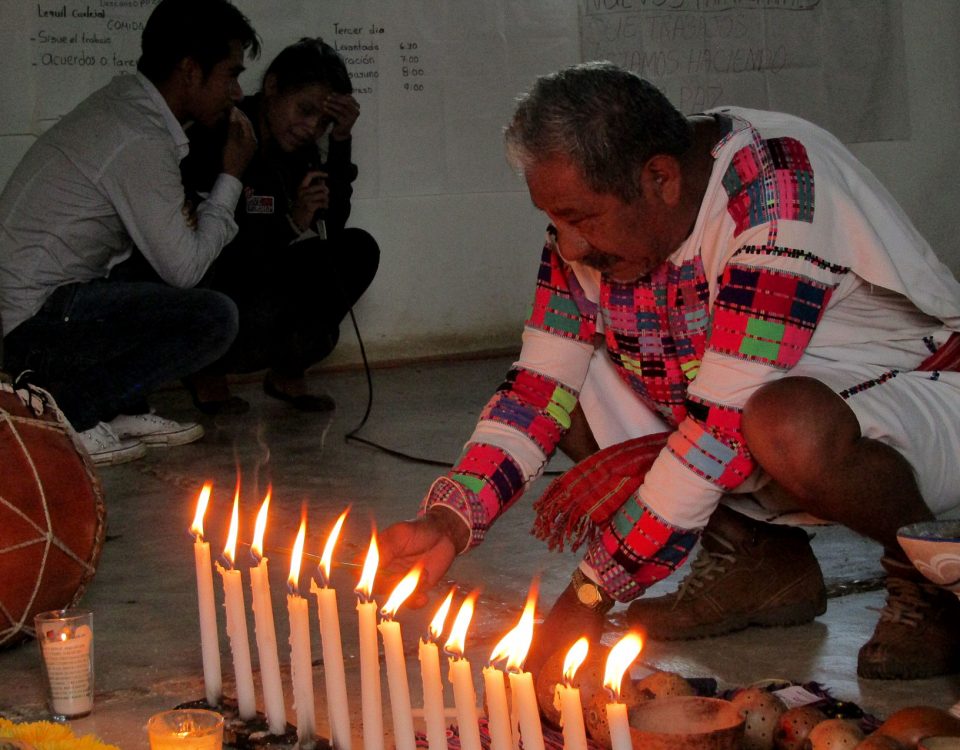
LATEST: COVID-19 – Health, economic and social Impacts increase
15/12/2020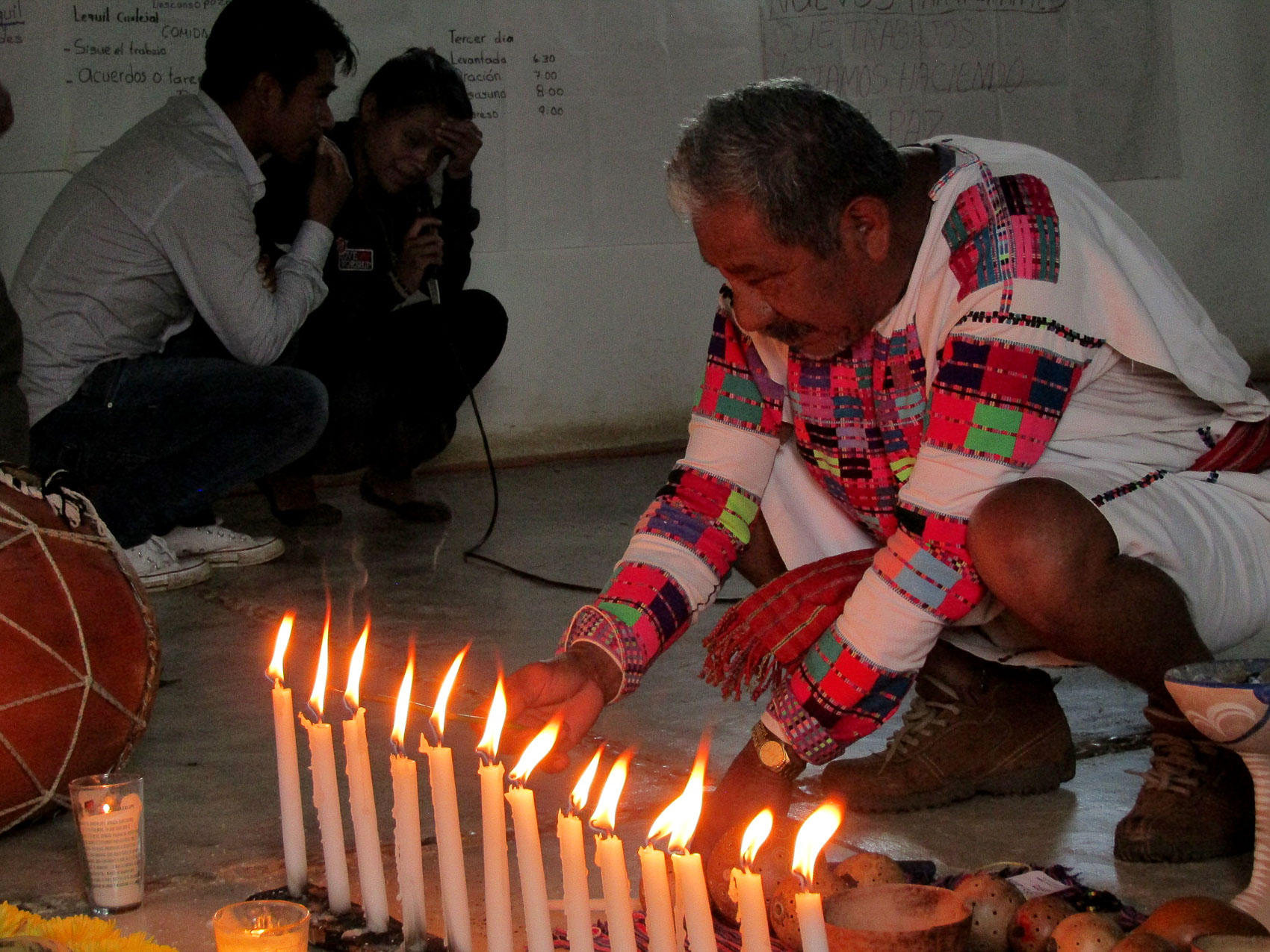
ARTICLE: The Contributions of Indian Theology in the Transformative Commitment of the Catholic Church in Chiapas
15/12/2020Sixteen months after its establishment, the National Guard (GN), a security body created in the current six-year term of office to confront crime, has 209 complaints against it for alleged human rights violations from January to September 2020.
. . . . . . . . . . . .
In May 2020, and in the midst of the pandemic, President Andres Manuel Lopez Obrador published a decree in the Official Gazette of the Federation in which he attributed special public security tasks to the armed forces and the Navy, “a measure to militarize the streets of the country as a way to guarantee the safety of citizens.
Participation of the Armed Forces (AF) in Public Security Tasks
T o understand the role that the AF play in Mexico today, it is necessary to look back at the events that triggered the army’s incursion into public security actions.
In March 1996, 167 deputies of the 56th legislature filed an Action of Unconstitutionality against the participation of the Armed Forces of Mexico in public security tasks. In other words, the deputies claimed that the army was violating the provisions of Article 129 of the Constitution, which indicates that “in times of peace no military authority can exercise more functions than those that have an exact connection with military discipline.” Despite this, the Supreme Court of Justice of the Nation (SCJN), ruled as constitutional the presence of the AF in public security tasks, as long as they were “under the command of civil authorities”, and that they could act at the request of civil authorities and subordinate to them, emphasizing that the action of the AF was not automatic (Rosado Pulido, 2020)
The shadow of another serious problem in the country would give cover to the idea that a military presence in the national territory was necessary: the intensification of drug trafficking, which made subsequent governments seek to combat organized crime at the hands of police bodies and armed forces, investing significant amounts of money in the purchase of weapons, military training and through a series of actions reorganizing the police forces.
Institutional Reorganization
Throughout history, the different federal governments have included in their priorities the reorganization of the police forces for different reasons. Some key examples are the creation of the Federal Preventive Police (PFP) in 1999 during the government of Ernesto Zedillo. The PFP was defined as a central element of the federal strategy to combat organized crime.
By 2000, Vicente Fox had created the Secretariat of Public Security (SSP), whose main function was to set up what would become the Federal Police (PF). During the government of Felipe Calderon, Mexico was experiencing the consequences of the alarming increase in violence, for which the ex-president declared that this institution had been unable to serve as a model for all the police in the country, and “proposed to reorganize the attorney general and create a single federal police under the command of a police Czar” (Cano, Toni, 2008).
Therefore, in 2009, the Federal Police was created as a decentralized administrative body of the Ministry of Public Security, whose objectives were, among others, to apply and operate public security policy. Despite this initiative, Calderon’s six-year term of office was one of the bloodiest, as a result of the so-called war against organized crime, with more than 1000 people killed during the first five months of 2007 and repeated human rights violations by the army, such as the case of Ernestina Ascencio Rosario, a 72-year-old Nahua indigenous woman, “who was repeatedly raped, beaten and tortured by several soldiers in the state of Veracruz, and later died as a result of the injuries” or the case of “two women and three children under the age of eight who lost their lives in the state of Sinaloa [while they] were traveling in a pickup truck, which was hit by 24 bullets fired by soldiers” (SIPAZ, 2007).
In 2012, during Enrique Peña Nieto’s six-year term, the Public Security Secretariat ceased to exist and the National Security Commission (CNS) was created, a body that, together with the Federal Police, became dependent on the Ministry of the Interior. In addition, during his government, Peña Nieto created the Gendarmerie division of the Federal Police, through which he sought to implement a “police operation and management model close to society”, again giving the perception of having changed the title without changing the militarized option.
However, the Federal Police were involved in issues of corruption, organized crime, money laundering (Lastiri, 2020), links with drug trafficking and multiple human rights violations, including the disappearance of the 43 student teachers from Ayotzinapa (Ramirez, 2020), revealing the high levels of corruption that existed in the institutions. What happened in Ayotzinapa was the turning point so that not only civil society organizations but society in general and to a huge extent began to demand a change of model.
The Contradictions of the new government and the National Guard
The election of Andres Manuel Lopez Obrador in 2018, brought with it the unknown of what the role of the new president regarding the actions of the armed forces would be. In his statements made during an interview conducted by the newspaper La Jornada one year after taking office the president said: “If it were up to me, I would dissolve the Army and turn it into a National Guard, I would declare that Mexico is a pacifist country that does not need an Army and that we would all do the defense of the nation, if necessary. That the Army and Navy would become the National Guard to guarantee security.” (La Jornada, 2019). However, his actions seemed contradictory, and it was later confirmed that the new president had decided to continue with the militarization model that he had criticized so much during previous presidencies, stating that “in the current circumstances there is no alternative” and that it would be “irresponsible on his part” to remove sailors and soldiers from the streets, as it would leave Mexicans in a “defenseless state.” This revealed the gap between his campaign promises and the current reality of the country, which seems to eliminate any expectation of a change of course in matters of security in this six-year term.
Thus, under the discourse that the crisis of violence in Mexico was due to “rivalry” and little cooperation between the different police forces in the country (Benitez Manaut, 2018), the president focused from the beginning of his mandate on the construction of what would be the new Secretariat for Citizen Security and Protection (SSPC), which would replace the armed forces in internal security tasks, and proposed the creation of a new police force that would allow the progressive demilitarization of the country: the National Guard (GN).
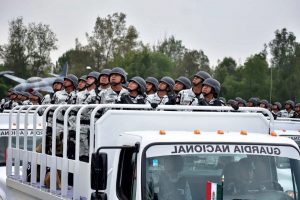
Elements of the National Guard refine details for the military parade © Jazmín Adrián – publimetro.com.mx
On December 31st, 2019, the Federal Police was officially dissolved with the intention of creating a civil police force where there was no corruption. However, the Secretariat for Citizen Security and Protection made an agreement for members of the Federal Police to be incorporated into the National Guard if they wished to do so. Furthermore, the transfer of 57 thousand members of SEDENA to join the National Guard was recently announced (Jimenez, 2020).
These decisions and agreements gave rise to the debate on the fact that the National Guard should be legally civil since, with the intention of reinforcing this new institution, the president has proposed that members of the army can join the GN as long as they have left their military post, which does not happen in many cases. It has even been shown that this “has been directed and managed from the beginning by active Army officers, who equally give orders as police chiefs and as commanders of the Armed Forces” and that the Secretary of National Defense (SEDENA) “gave a hand from its Military Police corps, but maintaining all its structure and its commands, and only renaming them with police letterheads and giving them some courses.” (Animal Politico, 2020).
The constitutional reform of the National Guard in which public security tasks are attributed to the armed forces in an “extraordinary, regulated, supervised, subordinate and complementary manner”, will be in force until March 27th, 2024.
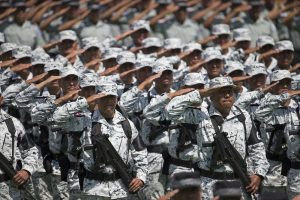
Members of the National Guard salute during the presentation of the new force at Campo Marte in Mexico City, Sunday, June 30, 2019 © AP Photo / Christian Palma
The document lists the new powers granted to the army, which allows us to verify that its incursion goes beyond crime prevention in urban areas or where the police normally operate, but also includes the surveillance of border areas; the control of customs sections, checkpoints, customs checkpoints, supervision centers; as well as migration control and surveillance of tourist areas. There are also tasks that were exclusive to the National Guard and that the armed forces will now be able to do, such as: “carry out the arrest of people and the seizure of assets related to criminal acts”, as well as “participate with other federal, local or municipal authorities in joint operations, among others” (Expansion Politica, 2020). The President has deployed 10,237 elements of the National Guard as security commissioners at PEMEX facilities; as well as the construction of the new “Felipe Angeles” Airport, in the State of Mexico. Another of the President’s assignments for the Army and the National Guard is the surveillance of roads and airports through the creation of the General Directorate of Roads and Facilities, as well as the General Directorate of Air Transport that will have 84 thousand 450 members (El Sol de Mexico, 2020).
President Lopez Obrador also promoted the bill to reform the law to “transfer the powers of the Ministry of Communications and Transport (SCT) over ports to the Ministry of the Navy (SEMAR)” (Infobae, 2020), that is, the militarization of the ports by which it is attempted to displace the civil authorities to give way to military authorities. In this sense, Andres Alcantara Silva, a lawyer from the Ibero-American University declared that “the powers that the SCT currently has in this matter will become the exclusive competence of the Navy, completely displacing the civil authorities.” Later in response to this, Senator Eruviel Avila assured that it is not about militarization but about strengthening the ports.
What Are the Implications of Militarization for Human Rights?
It is important to reflect on the indirect consequences of militarization in Mexico, mainly with the legalization of the new powers of the Armed Forces and what they mean for human rights. What must be done, according to Samuel Storr, Consultant of the Civil Security Program of the Ibero-American University, is not only an analysis of the militarization of civil authorities or turning the Armed Forces into the police, but a deep analysis of the use of force and to what extent it is legitimate, necessary and effective (Storr, 2019).
In this sense, it is clear that the absence of a legal framework that regulates the actions of the armed forces and encourages “transparency, accountability and accountability mechanisms” (Rosado Pulido, 2020) has resulted in the way in which the AF have carried out public security tasks. That is, by having a vision of eliminating the enemy, they make excessive use of force and the fatality rates are very high, reflecting violations of human rights or loss of human life. “The National Guard became the antithesis of what the MORENA government proposed, and it became a militarized institution, where to date 65,574 violent deaths have been registered; 63,793 malicious homicides and one thousand 782 femicides, so far during this administration and from January to September of this year, there have been 26,954 malicious homicides, of which 724 are femicides.” (El Dictamen, 2020).
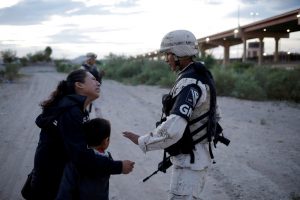
A Guatemalan woman asks a member of the Mexican National Guard to let her cross into the United States in Ciudad Juárez © José Luis González – Reuters
As stated by Christof Heyns, a member of the United Nations Human Rights Committee, who was in Mexico in 2013 as Special Rapporteur on Extrajudicial, Summary or Arbitrary executions “we have never seen that it is a good idea to have the military take on the job of the police” as they tend to escalate instead of diminishing conflicts (SIPAZ, 2020). For her part, Olga Guzman, Incidence Director of the Mexican Commission for the Defense and Promotion of Human Rights (CMDPDH) explained that “for more than 13 years, the participation of the military in public security has increased the illegal and indiscriminate use of the force, as well as crimes such as arbitrary deprivation of liberty, murder, torture, and forced disappearance. The improper use of their powers has been directed mainly against civilians, to whom they attribute membership of criminal organizations or their participation in criminal activities” (SIPAZ, 2020).
According to the National Human Rights Violation Alert System of the National Human Rights Commission (CNDH), the National Guard “has been accused of committing arbitrary detentions, intimidation, cruel and inhuman treatment, assaults against women, arbitrarily using the force, use of violence in a disproportionate way, committing acts of torture and illegal detentions.” Without controls to punish those who commit human rights violations, the military training of most of its members and their increasing presence on the streets are some of the factors that, according to specialists, have caused the GN to already have hundreds of accusations (El Universal, 2020).
The Armed Forces, Between Corruption and Impunity
In recent years it has been seen how corruption within the military institutions has led to many military and high command officials being involved in legal proceedings. A recent case (2018) is that of Genaro Garcia Luna, former secretary of Public Security with Felipe Calderon and head of the Federal Investigation Agency (AFI) with Vicente Fox, and with other positions in the Zedillo administration. Garcia Luna was accused of receiving “millions of dollars in bribes” from the former leader of the Sinaloa Cartel, Joaquin Guzman Loera, “El Chapo” (Forbes, 2019).
Another emblematic example is that of General Salvador Cienfuegos Zepeda, Secretary of National Defense in the government of Enrique Peña Nieto, who was arrested and accused of money laundering, trafficking in heroin, cocaine, methamphetamine and marijuana from 2015 to 2017. In addition, Cienfuegos’s time at the head of the Secretariat of National Defense (SEDENA), was characterized by the violation of human rights, he is indicated as being responsible for the Tlatlaya[1] massacre and the disappearance of the 43 disappeared student teachers from Ayotzinapa, both occurring in 2014 (Flores Meza, 2020). However, the charges against the former official were dropped by the authorities of the United States and in Mexico he has not been issued an arrest warrant so far. The links with organized crime and the violation of human rights in the Cienfuegos case would seem to not merit a legal process.
On November 13th, the first officer involved in the disappearance of the 43 students was arrested. Jose Martinez Crespo is accused of crimes such as organized crime, homicide and forced disappearance (SIPAZ, 2020). “The Armed Forces have been placed on a pedestal due to an alleged level of trust, but they have not escaped corruption and abuse” (Flores Meza, 2020). This is shown by the recent tests of trustworthiness carried out among the members of the National Guard, where 4,339 members did not pass said test (Gutierrez Gonzalez, 2020).
In 2012, the Supreme Court established “that the civil authorities should investigate and judge the abuses committed by the military against civilians under ordinary criminal justice.” However, there was very little progress in the processing of these cases during Peña Nieto’s administration. According to the Washington Office on Latin America (WOLA) “from 2012 to 2016, more than 500 investigations were opened against the military, but only 16 convictions were obtained” (Human Rights Watch, 2018). For its part, the Office in Mexico of the UN High Commissioner for Human Rights welcomed the criteria of the First Chamber of the Supreme Court of Justice of the Nation that recognizes that “cases of homicide during military activities where both parties, the active and the passive subject, belong to the army, fall within civil and not military jurisdiction.” (UN Human Rights, 2020).
Without a doubt, this government has demonstrated that it is following the line of militarization in matters of public security. We see, after several governments, that President Andres Manuel Lopez Obrador seems convinced that militarizing the streets is synonymous with security. The President even said in the middle of the year: “Although they criticize me that I want to militarize the country, I will continue to insist that the armed forces should help us in public security tasks, I am convinced that it is necessary.” And he assured that if there were any violation of human rights “it would be rectified.”
However, it has been observed that these situations have arisen and that there continues to be impunity, not only for the military but also for the highest command, who through corruption cover up the crimes within the institutions, even the Army, the Federal Police, the Gendarmerie, the National Guard or any other name with which it is baptized.
Historically, the Armed Forces have shown that there is a general tendency to use disproportionate force and abuse of power. The countless cases show how impunity and the lack of justice have allowed more and more human rights violations to go unpunished.
Notas:
-
[1] On June 30th, 2014, a military convoy allegedly killed between eight and 15 civilians, apparently part of a group of criminals that had previously attacked them. It happened in the municipality of Tlatlaya, in the State of Mexico, about three or four hours from the capital. The authorities arrested the soldiers and the Prosecutor’s Office accused them of murder and tampering with the crime scene, among other crimes. However, a magistrate released them due to lack of evidence (Ferri, 2019).
References (AS BELOW)
- Animal Político. (19 de octubre de 2020). Mandos militares controlan a la Guardia Nacional, confirma amparo de Mayor del Ejército. Obtenido de Animal Político.
- Benítez Manaut, R. (noviembre-diciembre de 2018). México: los militares en tiempos de cambio. Revista Nueva Sociedad (278). Recuperado el 15 de noviembre de 2020, de Nueva Sociedad.
- Cano, Toni. (23 de octubre de 2008). Calderón quiere una policía lejana a los narcos. Obtenido de Diario de Córdoba.
- Clarín. (6 de noviembre de 2020). AMLO: la ONU pidió al presidente de México que revise la militarización de las calles. Obtenido de Clarín Internacional.
- El Dictamen. (4 de noviembre de 2020). México vive época más violenta en su historia: Julen Rementería. Obtenido de El dictamen.
- El Sol de México. (22 de octubre de 2020). Ejército vigilará carreteras y aeropuertos. Obtenido de El Sol de México.
- El Universal. (5 de novembre de 2020). Guardia Nacional, en top 10 de violación de DH. Obtenido de El Universal.
- Expansión Política. (11 de mayo de 2020). AMLO decreta que las fuerzas armadas participen en la seguridad pública. Obtenido de Expansión Política.
- Ferri, P. (3 de julio de 2019). Los militares mexicanos acusados de la masacre de Tlatlaya podrían volver a prisión. Obtenido de El País.
-
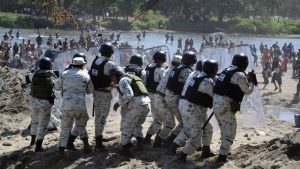
On January 20, elements of the National Guard repelled hundreds of migrants who tried to enter Mexico © Reuters
Flores Meza, D. (22 de octubre de 2020). Corrupción y abuso castrense a la mexicana. Obtenido de La Jornada del Oriente.
- Forbes. (10 de diciembre de 2019). Genaro García Luna: de superpolicía de Calderón, Fox y Zedillo, a preso por narco. Obtenido de Forbes Política.
- Gutiérrez González, R. (19 de noviembre de 2020). 2 de cada 10 militares y marinos reprueban control de confianza en GN. Obtenido de La Silla Rota.
- Human Rights Watch. (4 de octubre de 2018). México: La militarización de la seguridad pública. Obtenido de Human Rights Watch.
- Infobae. (21 de octubre de 2020). Avanza en el Senado la militarización de los puertos propuesta por López Obrador. Obtenido de Infobae
- Jiménez, B. (14 de noviembre de 2020). Transfieren a 57 mil elementos de la Sedena a la Guardia Nacional. Obtenido de Diario mx.
- La Jornada. (1 de julio de 2019). AMLO: el gobierno fue secuestrado; salvó al país su grandeza. Obtenido de La Jornada.
- Lastiri, D. (27 de octubre de 2020). Interpol emite ficha roja contra Jesús Orta y Frida Martínez, exsecretarios de la Policía Federal. Obtenido de El Universal.
-
ONU Derechos Humanos. (13 de octubre de 2020). ONU Derechos saluda que los homicidios de militares en México sean juzgados por corte civil. Obtenido de Noticias ONU.
- Ramírez, C. (24 de octubre de 2020). El policía federal reprobado en confianza, relacionado con el narco y los 43: EEUU le seguiría la pista a Omar García Harfuch. Recuperado el 15 de octubre de 2020, de Infobae.
- Rosado Pulido, O. M. (25 de junio de 2020). Origen de la militarización de la seguridad pública en México: análisis histórico de la Acción de Inconstitucionalidad 1/96. Obtenido de Centro de Estudios Constitucionales SCJN.
- Sipaz. (31 de agosto de 2007). ENFOQUE: Militarización en México, grave amenaza para los derechos humanos. Obtenido de Sipaz.
- Sipaz. (13 de noviembre de 2020). Nacional: Detienen a un militar vinculado al caso de los 43 normalistas de Ayotzinapa. Obtenido de Blog Sipaz.
- Sipaz. (3 de septiembre de 2020). Nacional: Se llevó a acabo el Webinario “Militarización de la seguridad pública en México”. Obtenido de Sipaz.
- Storr, S. (18 de junio de 2019). Informe sobre intervención militar en la seguridad ciudadana. Obtenido de Ibero MX.

